Articles
On this page: Notes
on the Building | Studio
Acoustics | Designing the New
Studios
The Architecture | Decoration of the Studios | The Control Room Amplifiers
How Broadcasting House is Run | Ultra-Short Wave Broadcasting | Television in 1932
The Architecture | Decoration of the Studios | The Control Room Amplifiers
How Broadcasting House is Run | Ultra-Short Wave Broadcasting | Television in 1932
Here is a selection of articles from the BBC Year Books from 1931 to 1934. In the first one, from 1932, the architect of Broadcasting House discusses some of the thinking that went into the design of the building.
NOTES ON THE BUILDING
By the Architect, Lt.-Col. G. Val Myer, F.R.I.B.A.
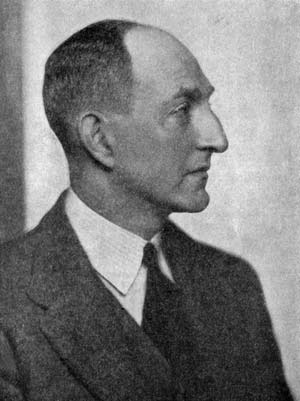
Lt.-Col. G. Val Myer
It is imagined, in many quarters, that
"modern" architecture has revolutionised the whole of present-day
practice, whereas the truth is that good architecture has always been a
matter of common-sense, plus a leavening of aesthetic instinct. In
reality, its vital principles are no different today from those which
guided the old Egyptians, Greeks, and Romans.
In planning a building, the first essential, of course, is to make it suitable for the purpose for which it is intended. That it should be pleasing to the eye is, obviously, a further necessity, but, if it looks suitable, its designer is already halfway towards achieving his object.
In the case of Broadcasting House, we had first to consider its functions. These are twofold; the actual broadcasting, and the administration of broadcasting. Obviously, the studios, Control Room, and the accommodation of technical equipment come first, with the actual studios as the most important factor of all.
In planning a building, the first essential, of course, is to make it suitable for the purpose for which it is intended. That it should be pleasing to the eye is, obviously, a further necessity, but, if it looks suitable, its designer is already halfway towards achieving his object.
In the case of Broadcasting House, we had first to consider its functions. These are twofold; the actual broadcasting, and the administration of broadcasting. Obviously, the studios, Control Room, and the accommodation of technical equipment come first, with the actual studios as the most important factor of all.
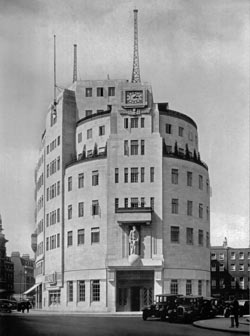
After exploring scores of different systems of planning, the problem of accommodating a large number of studios and their suites within the space available was quite suddenly solved. Instead of the studios being all on one floor, or on two floors, they would be all in one tower, so that, given a good service of lifts, circulation would be actually easier than if they had been all on the same level, and, of course, larger and more shapely studios could be provided.
Once this key idea had been found, the plan was rapidly developed and, one after the other, its benefits appeared. The evolution of the plan proceeded on simple lines which can best be expressed as follows :-
Studios must be insulated from sound - Put a thick brick wall round them, omitting the usual steel framework.
Studios must be artificially ventilated, so need have no windows - Put them in the centre of the building, where there is least daylight to waste.
Offices must have daylight - Put them all round the outside of the building, where plenty of daylight is available.
Studios need to be sound insulated from one another - Put between them horizontal layers of rooms such as Music Libraries, Book Stores, etc., which neither create noise nor are disturbed by it.
In this way, item by item, the plans were wrestled with and were slowly developed to their present form. Sometimes, as a result of much thought, whole features had to be discarded. Such was the fate of a huge parking garage, at one time accommodated in the basement.
I could fill many pages with the history of planning this building, with all its exacting requirements, but, interesting as this would be to myself, this is, perhaps, hardly the place for such a story.
Before speaking of the exterior, I will just say a word about the internal decoration of the principal apartments.
Related page
Related page
Related page
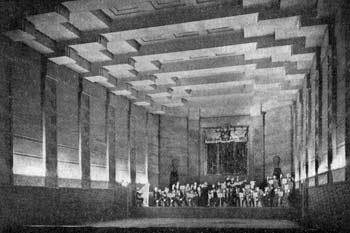
At the time of writing, this Hall is being finished in the rough for my scientific colleagues to test its acoustic qualities, and it is only after we have their results that a decision will be made as to the actual materials with which the design will be clothed.
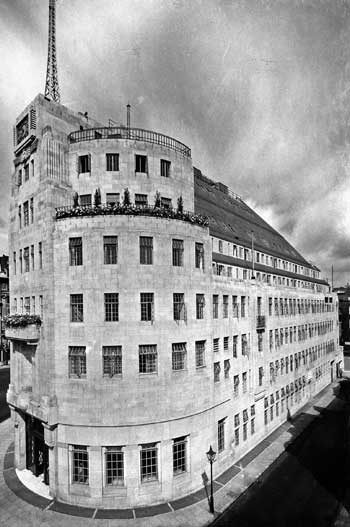
In Portland Place, the only limit of height was that imposed by the London Building Act.
The south end of the building, facing down Regent Street, suffered under the same difficulties as the Langham Street front, but at this vital point, realising my troubles, the parties concerned made certain concessions of real value.
In the circumstances, the obvious course seemed to be to design a symmetrical facade to Portland Place which would dominate the whole building, to emphasise the main doorway facing south by placing a Clock Tower above it, and to be satisfied with a modest elevation to Langham Street which, without being striking, would be suitable.
The marrying together of these three components was a particularly interesting problem, which was helped by the provision of a third aerial mast over the Clock Tower.
At an early date I realised that the site possessed a rare virtue in the long curve of the western side, and so, in organising the proportion of my masses and the play of light and shade, I tried to make full use of the gracious horizontal lines which this curve suggested.
Broadcasting House is said to look bigger than its actual dimensions. This is due to the scale and number of the windows, necessitated by the provision of an immense number of small offices. Endless flexibility of subdivision of offices was required by the Corporation, which fact, naturally, weighed with me in preparing my design for the façade.
Although economy was essential to the whole scheme, and the sculpture at my disposal limited, I insisted that it be as good as possible, and then placed it, with other architectural features, at the most effective points, hoping to set it off to advantage by the contrast of plain walling and the considered rhythm of the windows referred to above.
Before concluding, I must pay tribute to the courtesy and extraordinary ability of Mr. M. T. Tudsbery, Civil Engineer to the B.B.C., who has been associated with me in the work for nearly four years. Another debt of gratitude is due for the many excellent suggestions which I have received from Dr. M. J. Rendall in matters of artistic taste.
From the 1931 Year Book STUDIO ACOUSTICS
Probably the most important property of any room or hall used for listening to speech or music, whether through the medium of broadcasting or not, is what is termed the reverberation time. To recapitulate briefly, if in any ordinary room a source of sound (such as a musical instrument which has been playing a sustained note) suddenly ceases, the sound is still heard for a short period, the duration of which will depend on the amount of sound absorbing material in the room. The time in seconds taken for a fairly loud sound to die away to inaudibility under these conditions is called the reverberation time, and is a definite property associated with the room. In more scientific language, it is the time taken for the average sound intensity in the room to die away to one millionth part of its initial value.
Now it has been found by experience that for a room of any particular size, the reverberation time must have a definite value in order that music may be heard and appreciated at its best. For a fairly large studio such as is used by the B.B.C. for performances by an orchestra of medium size, the required reverberation time is about one second. For a small studio, used for solo items, for combinations of a few instruments, or for talks, the required value is still less, whilst for the largest studios, or for concert halls used for broadcasting, it may be two seconds or even more.
That some limitation of the reverberation period of a studio is necessary was recognised from the early days of broadcasting, when the normal treatment was to introduce into the studio a large quantity of drapings or curtains, with which the walls were covered. Sometimes as many as five or six layers of curtains were used.
Such treatment was far from satisfactory for several reasons. First, it was found that no matter what quantity of curtains were used, a really pleasing reproduction of music could not be attained. If too little draping were employed the result was "echoey" and unpleasing, whilst as the quantity of deadening material was increased the result became dull and lifeless with none of the brilliancy which would be a normal feature of the performance. The psychological effect on artists was very similar. They found difficulty in performing in the early studios, by reason of both the deadness to the ear and the depressing effect to the eye, for a heavily draped studio does not lend itself to pleasing decorative treatment.
The reason for these difficulties is now apparent, for it has been found necessary to take considerable account of the variation of reverberation time with pitch or frequency. The earlier measurements of reverberation time, whether in connection with broadcasting or undertaken in the study of architectural acoustics, were almost always made at a frequency of 512 cycles per second, corresponding with a pitch of one octave above middle C. It is necessary, however, in order to determine the acoustic behaviour of any room or studio, to make determinations of the reverberation time at various pitches or frequencies, and so obtain a reverberation-frequency characteristic, showing the value of the reverberation time throughout the musical scale.
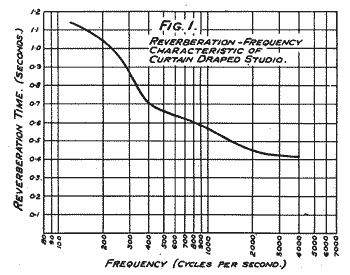
Any increase in the quantity of draping material would only reduce still further the reverberation at high frequencies, whilst making little change at the low. If indeed, by the use of an exceptionally large quantity of draping, the low-frequency reverberation were reduced to the desired value, the studio would be practically without reverberation at the higher frequencies. This was, in fact, the condition of the first studios used in broadcasting.
The problem of providing studios possessing a suitable reverberation time, independent of frequency, really resolves itself into that of finding sound-absorbing materials which are equally effective at all frequencies, and which are at the same time susceptible to decorative treatment without the destruction of their acoustic properties. The general requirements of such a material will be realised when it is understood that the sound waves at the higher frequencies seem to be absorbed in the pores of the material itself, losing their energy by multiple reflections from side to side of the minute apertures which form a large part of the surface of a porous substance. The sound waves of the lower frequencies, however, are apparently most readily absorbed when the whole surface of the wall is capable of yielding under the variations of pressure exerted upon it by the sound waves.
A compressible porous material is therefore required for the successful treatment of a studio. Ordinary hair felt, if of loose texture and of sufficient thickness, fulfils these conditions fairly well, and has been used to a considerable extent in the treatment of B.B.C. studios in the last few years. The chief difficulty in the use of felt, in common with that of many other possible materials, is that of providing suitable decorative treatment. One method of decoration has been to cover the surface of the felt with a loose-textured wall-paper. This, however, destroys the porosity of the felt, and very considerably reduces its absorptive properties at the higher frequencies, producing unduly long reverberation at those frequencies,
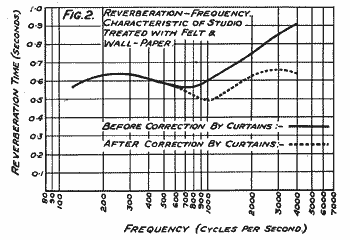
Fortunately a fairly simple corrective treatment can be applied by making use of the fact that light curtains are most absorptive for the highest frequencies. It is possible to calculate, data being available regarding the properties of the curtains, exactly what area of wall surface must be curtained in order to produce the best effect. In the particular case under consideration the covering by light curtains, hanging in loose folds, of nearly one-third of the total wall surface resulted in the curve shown by the dotted line of Fig. 2. The undesirable buzz was found to have entirely disappeared as the result of the treatment and the studio to be very suitable for broadcast transmission.
A more suitable material for studio treatment would, however, appear to be felt with a decorative treatment of some fabric such as tapestry or fine canvas, preferably stretched over the surface of the felt. Such treatment is being tried in the construction of new studios, whilst at the same time a thorough investigation of new materials and methods of treatment for use in the future is being made.
It is hoped that in due course it will be possible so to construct studios that the use of artificial echo, as at present employed, will be avoided. There seems no inherent reason why it should not be possible to modify the acoustics of the larger studios so as to produce an effect similar to that of the most popular of the outside concert halls and other buildings from which broadcasting is conducted.
From the 1932 Year Book DESIGNING THE NEW STUDIOS
The general question of the design of studios for broadcasting, and the nature of the technical problems involved, were fully discussed in the issue of the Year Book for 1931 (see above). It is unnecessary, therefore, to deal again with the whole of the theoretical side of the question, and it is proposed to confine the present article to a discussion of the application of the general principles to the particular problem of the design of studios for Broadcasting House.
Readers may remember the statement made in the article referred to above, that the most fundamental property of a studio, which largely determines its suitability or otherwise for broadcasting, or even for direct listening, is its "reverberation time," and the dependence of that property on frequency or pitch. The reverberation time is the time, expressed in seconds, taken for a fairly loud sound of the frequency concerned to die away to inaudibility after the source has ceased to operate. Defined in scientific terms, it is the time taken for the mean sound intensity in the room to decay by 60 decibels, that is to say, to one millionth of its original value. It is quite definitely related to the volume of the room and the amount of sound-absorbing material which the latter contains, and simple mathematical expressions have been derived whereby it may be calculated, with reasonable certainty, in advance of construction.
Experience has shown that so far as studios to be used for musical performances or for general purposes are concerned, the desirable reverberation time does not differ greatly from that which would give the best conditions in a room of the same size intended to be used as a music room or small concert hall with no reference whatever to broadcasting. It must be understood that if the reverberation time of a given room is too high, the result sounds "echoey," all definition is lost in music, and speech becomes very difficult to understand. If, on the other hand, it is too low, music is clear and distinct, but the effect is dull and lifeless, and reminiscent of that obtained in the open air. The determination of the actual value of reverberation time which will give the desired mean between these two extremes can only be made by making measurements of the reverberation time in halls and rooms which critical musicians consider to be acoustically good. It is necessary to realise that whilst scientific methods may be employed in the design of a room so that it may have certain characteristics, the decision as to what those characteristics should be must remain largely a matter of experience and musical opinion. Such measurements have been made by various authorities, and the optimum reverberation time of a given room is found to depend on its volume. The larger the room is, the longer must its reverberation time be for the best conditions.
In designing the studios for Broadcasting House the optimum reverberation time has been taken to be slightly less than would be the case if the studios were to be used for direct listening, without the medium of the microphone. There are two reasons why the accepted time for direct listening has been somewhat decreased. The first is, that in listening by means of a loud-speaker, the reverberation time of the listener's room has to be taken into consideration, being virtually added, so far as the final effect is concerned, to that of the studio. The second is that broadcast listening is effected with the aid of a single microphone, and is therefore the equivalent of monaural listening. For some psychological reason, not fully explained, the effect of reverberation is more noticeable in monaural than in binaural listening, on the basis of which the accepted values of optimum reverberation time were determined.
As concrete examples of the reverberation time for which various studios are being designed, the large studio or Concert Hall, which has a volume of very nearly 150,000 cu. ft., is to have a reverberation time of 2 seconds; the Vaudeville Studio, 3,000 cu. ft. in volume, is to be of 1.3 seconds period, whilst a small Debates Studio is being constructed to have 0.6 second reverberation, corresponding with a volume of 2,200 cu. ft.
As has been already indicated, the variation in reverberation time which takes place with frequency or pitch is of the utmost importance, and the Broadcasting House Studios are being constructed, as far as possible, to possess reverberation independent of pitch. This means that the rate at which the sound energy in the studio dies away is the same for all notes within the musical scale. Where it is not possible to fulfil this condition exactly, the reverberation time is allowed to decrease somewhat towards the higher or treble frequencies, the maximum reverberation time being that which is determined from accepted data as described above. No marked increase in reverberation time for any part of the frequency scale is, however, to be tolerated.
A certain school of thought in acoustical work considers, on theoretical grounds, that the reverberation time of a good auditorium should be very definitely greater for the lower frequencies than for the remainder of the scale. There is room for considerable difference of opinion in this respect, but even if the suggestion is true under certain circumstances, such conditions may be dangerous for broadcasting on account of the difficulties of "bass blasting" which occur as the result of excessive reverberation at the lower frequencies. Still less can any increase in reverberation towards the higher frequencies be allowed. Should this occur, reproduction is characterised by a marked "edge" and excessive brilliance, which is most unacceptable to musical taste.
In a concert hall of the ordinary type, a very large part of the sound absorption which limits the reverberation time is due to the audience itself, and this constitutes a very serious difficulty in the design of such buildings to satisfy acoustical requirements, since an audience represents a variable quantity, and consequently the best the designer can do is to compromise in the matter of reverberation time, making his conditions right when only a part of the full audience is present. In broadcasting studios this difficulty does not arise, to so great an extent, but it now becomes necessary to discover materials with which to treat the greater part of the wall surface to provide the necessary absorption. Clearly if the reverberation time of the completed studio is to be practically independent of frequency, the same must apply to the absorptive properties of the sound-absorbing materials. At the same time these materials must be susceptible to a certain amount of decorative treatment without losing their acoustic properties. Two types of material are being specified for the majority of studios in Broadcasting House. Of these, one is ordinary "building board" or "insulation board," composed of wood pulp, cane fibre or similar material, and the other is a treatment which has found a certain amount of use in B.B.C. studio construction in the past, namely, "felt and wall-paper treatment" consisting of a layer of I in. hair felt applied to the wall surface and covered with one or more thicknesses of lining paper and a soft porous type of wall-paper for decorative purposes. Both of these materials, if certain precautions are taken, possess absorptive properties sensibly independent of frequency. Both must be stuck firmly in contact with a rigid wall surface, and not supported on battens out of contact with the wall. Neither must be subjected to decoration involving any form of paint or distemper which will alter the characteristics of the surface of the material. Colouring by means of stains or water-colours is, however, permitted, whilst an alternative method is to stretch very thin decorative fabrics over the surface of the sound-absorbing material.
Whilst the majority of the studios in Broadcasting House are being acoustically treated in accordance with the principles outlined above, several, to be used for talks and dramatic effects, are being made acoustically "dead." This means that their reverberation time is to be made as small as possible by covering the walls and ceiling with a material which absorbs a very large proportion of the sound energy reaching it. The material which is employed is known as "Rock Wool." It is composed of a mass of vitreous fibres and is applied between battens to the wall surface to a thickness of several inches.
The reason for the adoption of this treatment in the case of talks studios is that it is plainly desirable for the listener using a loud-speaker to get the impression that the speaker is addressing him in his own room, whether the latter happens to be large or small. If this is to be the case, the sound of the voice must be modified only by the acoustics of the listener's room and not by any effect emanating from the studio. Hence the studio is so treated that as little reflected sound as possible reaches the microphone. In the case of the dramatic effects, varying degrees of reverberation are necessary for different purposes, and these are obtained by adding "artificial reverberation" by the use of a so-called "echo room" to any desired extent, as described in the B.B.C. Year-Book on previous occasions. Here again, therefore, the studio itself must possess the property of reverberation to as small a degree as possible.
From the 1933 Year Book, but originally published in The Listener of 13th July, 1932. THE ARCHITECTURE
By Professor C. H. REILLY
Professor of Architecture in the University of Liverpool.
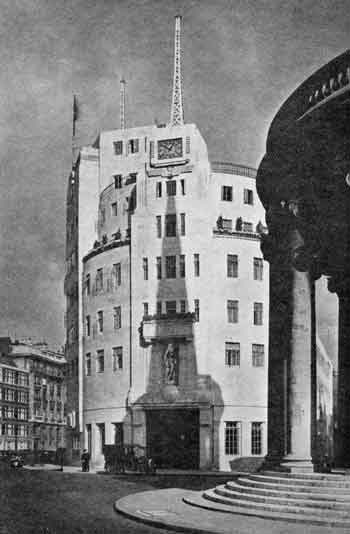
The south front and main entrance of
Broadcasting House in the shadow of All Souls church.
The programme in this case was a unique and inspiring one, a problem indeed to fire the imagination of the architect and everyone else concerned. The main portion of it, in impressiveness, if not in required cubic contents, was the provision of a mass of insulated concert halls and studios, from which music and messages of every kind would be sent out world-wide, and that not as the effort of private enterprise as in some other countries, but as representing the nation. That, at any rate, is how that part of the programme would appeal to the architect, seeking, as he must always do, to give the noblest possible expression to his client's building. Subsidiary to this central function of the new building, but actually occupying a great deal more floor space, was ordinary office accommodation for the six hundred odd persons in one way or another organising this new and exciting public service. Such office space, of course, like nearly everything else, is capable of fine architectural expression, but it will be admitted at once that it does not offer a new or unusual programme. It is indeed the programme which most of the buildings in the central areas of all large towns are designed to answer. This office accommodation, therefore, should not be permitted, if the site were sufficiently large, to overwhelm the more distinctive portion of the building. That it has not entirely done so in the new B.B.C. building is a great tribute to the architect, Colonel G. Val Myer. In spite of having to wrap his studio block completely round with offices, so that externally the most distinctive portion of his structure does not show at all except for the short length of plain walling with seven small roundels in it at the top of the Portland Place front and the three small steel receiving aerials on the roof, he has certainly managed to give to his building a different air from that of the ordinary office block, and to suggest that it serves some new purpose. His building does not look, fortunately, like an ordinary Government office, nor an ordinary block of offices; nor a hotel. One is arrested by it and certainly, if one did not know, would ask what it was. We will leave it at that for the moment.
Let us return to the part of the programme involved in the site. It is an oddly shaped site rather like a lopsided potato or sausage balloon tapering to a roughly rounded nose facing down Regent Street, with a long bulging side to Portland Place and a straight one to the back street. At the end opposite the rounded nose the site is cut off sheer by the adjacent property. Its length is about 200 and its width in the middle is about 120 feet. It is very significant, both of the amount of accommodation the architect had to fit on to this site and of his consequent difficulties in properly articulating and expressing its various functions, that he has had to fill the site completely from end to end and side to side, save for a small area for neighbourly accommodation at the truncated end. He has not been able to allow himself any of the ordinary lighting courts a building of this width would call for. Except for his external layer of offices, therefore, his building has had to be lighted and ventilated artificially, and very well it has been done. To get everything in he has had, in addition, to carry his building up everywhere to the full height the London Building Act permits. If one had to fill a sack entirely full with any substance, one would obviously have considerable difficulty in arranging in addition expressive folds in the sacking, if that were one's object too, as it must always be with the architect.
A further difficulty of this site was that it was commanded by rights of light by the buildings in the back street. This is the reason why the end of the new building looking down Regent Street is so unbalanced at the top. One side has been sheered off as it were by the windows in the buildings opposite. How the directors of this great enterprise, with a future no one can foretell, but one certainly of increasing not decreasing activity, came to choose such a site it is a little difficult - for an outsider like myself to understand. One would have thought that they would have made every effort to have obtained a free open site instead of a restricted street one, a site, that is to say, where their building could have expanded upwards and outwards, as best suited its peculiar character. No doubt in the central position required it would be difficult to find such a site, though one nearby at once jumps to the eye for so unique an occasion.
It is the site which used to be suggested for that unfortunate ghost of a dream the National Theatre, a site in Regent's Park itself facing directly down the great avenue of Portland Place, the widest street in London. There the big block of concert halls and studios, windowless, but all the more significant for that, might have grown into a great dominating central tower round which, at appropriately lower levels, could have been grouped the office accommodation in proper subsidiary relationship. It would be difficult for an architect to imagine to-day a more thrilling programme than for such a building on such a site. One does not, of course, want to see the parks encroached upon for any ordinary purpose, but if Hyde Park could admit the Albert Memorial, Regent's Park might well have provided on its edge a worthy position for so striking a form of modern expression as a great broadcasting building for the metropolis.
Related page
Immediately behind this entrance hall is the great central core of the building, following the outline of the site and surrounded from top to bottom by a thick wall. This is the central studio block, and once the artists have passed into it from the entrance hall they cross no administrative portion of the building. Their cloak rooms, rest rooms, refreshment rooms and lavatories and, of course, all their studios and concert halls, are within it, artificially lit and ventilated. In persuading the authorities to allow artificially ventilated retiring rooms the architect has, it may be hoped, achieved a very valuable precedent which will in future permit such rooms to be placed in the dark portions of the plan instead of against external walls only, an economy of space and light long since practised in America. When the artists have finished their work they pass out the same way. If, however, instead of going through the central doors for the artists one goes to the right or to the left or takes the corresponding stairs or lifts, one enters, at any floor, the long office corridor which completely encircles the studio block. This corridor serves the layer of offices one room thick which everywhere occupies the external face of the building.
The offices need not detain us. They are straightforward well-lit rooms, neither too high nor too low, without ornament but with an air of efficiency which one expects to-day but which was hardly to be found five years ago. Occasionally there is a suite of rooms for a director or sub-director and these have simple panelling. There is a board room treated in the same way, fortunately free from the loops of carved fruit and flowers our bankers still require for complete happiness. Above the entrance hall there is a fine circular conference hall, a little more strongly modelled but still retaining the air of efficiency which is the keynote of the interior.
We now come to the buried studio block in the centre of the structure, the holy of holies, the mysterious heart to which I am sure the architect would have liked to have given fuller expression on the exterior had his site allowed
Further down this page
Related page
The other studios do not come within the scope of this article, but up above
Related page
Related page
Such ornament as there is, the decorative coat of arms and the interesting frieze of birds and rays of light on the balcony front, designed by the architect, and the impressive reliefs by Mr. Eric Gill at the base of the two bays flanking the Portland Place front are, like the building itself, restrained and forceful. Mr. Gill is to fill the great niche over the entrance door with a bronze group and it is not fair to judge this front until this is in place. As already pointed out, this front can never be symmetrical owing to the exigencies of the site. Its overloading on one side like a naval aircraft carrier is probably the reason why the building has been likened so often to a ship sailing down Regent Street. If, however, one mentally restores the missing blocks of building one sees at once that this front, if not so placid and dignified as the great curved one, would, nevertheless, come to rest as a stable and solid monument. In an age of transition then, on a difficult and restricted site, and with the most interesting things in his building necessarily hidden, one can congratulate the architect on a very notable achievement. One is a little less certain about congratulating the B.B.C. who set him the problem.
This article from the 1933 Year Book has been quoted from on the pages dealing with the studios but is here reproduced complete. THE DECORATION OF THE STUDIOS
By Lord Gerald Wellesley, F.R.I.B.A.
The interior of Broadcasting House is the most important example of untraditional decoration yet completed in this country. The accumulated rubbish or wisdom of the ages has been washed away, and something which is definitely and entirely new has taken its place. Such a phenomenon has never occurred before in the world's history. Taste in building and the trappings of life generally has always been in a state of flux and change, but its evolution has hitherto been gradual, even when enforced by political upheavals. It is therefore natural to wonder why in our time we have not been able to make a complete success of a gradual evolution and adaptation of traditional forms to modern conditions. The Swedes can do it, and to some extent so can the Austrians; but in England such attempts, at any rate in vast town buildings, seem poor anæmic affairs sadly timid compared with honest, stark, functionalism.
Nevertheless, though tempered traditionalism may be unexciting, it is in many instances justifiable and can in no circumstances arouse the disgust and ridicule which profuse untraditional and newly-invented ornament causes. How pathetically old-fashioned is the immensely elaborate carved wooden room set up during the first years of the present century in the Musée des Arts Décoratifs in Paris. Will the future ever produce a defender of the luxuriant decorative orgies of that manner which we used to call "the Art Nouveau" and the French "le modern style"? The epoch will, of course, in time find admirers among those who have a great "sense of period." But surely no one will ever want to live in an elaborate "modern" room of the year 1902. The fallacy that you can invent architectural ornament was not dead in the year 1925 when the great Exhibition of Decorative Art was held in Paris. The buildings and rooms bristled with rows of silly flutes and yards of zigzags, which lacked the great traditions of the egg and dart or the Greek fret and were every bit as meaningless. To lay down any law in the realm of aesthetics is difficult, but a strong case can be made out for the proposition that something really new happened in architecture and decoration when it was realised that you cannot invent your own architectural ornament. You must either use what has come down to you through the ages or else do without.
Now I do not mean by this that no concession to the pleasures of the eye should be made in a modem building. All sorts of things to please the eye can be done without resorting to sinkings and projections. In the first place there is no reason why sculpture should not be used. Let there be no nonsense about the sculpture being part of the construction of the building. It is there purely to adorn it precisely as a room is adorned by a picture or a vase of flowers. When it comes to the inside of a building the possibilities of embellishment possessed by the architect are almost as great as those of an eighteenth-century predecessor. Of course he must not resort to a cornice, or moulded door architraves or skirtings or panelling or a great carved and moulded fireplace forming a climax to a room like the altar to a church. But in revenge he can make all this seem fussy and commonplace in contrast with the clean simplicity of his lines, with the subtle harmonies in colour, which the complete absence of projecting decoration seems to indicate. But above all he can do anything he likes with his lighting. He can toss it from surface to surface, he can throw it up and down. He can diffuse it if he wishes or he can concentrate it to emphasise some feature of his room. It is his slave, as water was the slave of the baroque garden architect. This god-like power to bend light to the will of man, which is the greatest advantage that the designer of to-day has over his predecessors, is peculiarly important at Broadcasting House as, with one exception, the studios, for acoustical reasons, are all embedded in the centre of the building and are never lit by the crude untamable sun.
Another fundamental difference between the room of the past and the truly modem room is the importance which the few decorative objects which are allowed to enter it assume. A Georgian or Victorian room may well contain thirty articles the sole function of which is to adorn. They are, in fact, what old fashioned housemaids call "ornaments." The modern room contains two or three. One vase filled with flowers, real or artificial, one picture and one statuette on a table - a bare three ornamental objects form quite a liberal allowance for a new room. But then how interesting each becomes. A tall vase with two lilies, placed in a niche and lit from below, is far more arresting than a table covered with fifteen full flower vases which have taken half an hour to arrange. This Japanese economy in objects the sole function of which is to embellish is of the very essence of modernity. The thrill that a vase of flowers or a cactus gives in the setting of a modern room is unexpected and difficult to analyse. It is like a living, articulate, voice in a well of silence. It is the one note which breaks the repose, the one place where rowdy colour flashes and exuberant forms are allowed. Place the same vase on a table in some old-fashioned drawing-room and it would not be noticed. The use of flowers and plants in Broadcasting House is masterly and in many cases forms an essential element in the decorative scheme.
The designers of the studios have in no case had a free hand. They have always had to conform to given proportions of reverberating and non-reverberating substance on their walls. These proportions vary in the different studios. The materials most used are "Donnacona" or "Tentest" wall-boards, made in large sizes and having a rough texture, hard synthetic resin sheets, plywood, and various stuffs. Except the rough wall boards these materials may be of any colour. Although the use of given proportions of these materials as wall coverings meant a strict limitation to the designer's fancy, the mere fact that so much was decided for him was probably a help. A severer limitation was the ban on all foreign imports. Many of the substances used had therefore to be made in England for the first time. Moreover, there is practically no room in Broadcasting House which is a plain rectangle; but this would have been a severer handicap to designers on traditional lines, as would also the rows of small upright apertures demanded by the very efficient ventilating system.
It may be asked why so much care should be lavished on the finish of the studios which are only seen by the broadcasters. Why is more required than, for instance, the standard of finish to be found behind the scenes in a theatre? To such utilitarian questions the reply is that the atmosphere of a broadcaster's surroundings affects his performance. Bright bands demand bright rooms: talkers want intimate little studies: religious performances must take place in a temple-like structure elaborately unsectarian, and plays and sketches must be staged in something resembling a theatre.
The resolution of these difficult and delicate problems was entrusted to different designers whose work we will now examine in detail. Lieut.-Colonel G. Val Myer, the architect of the whole building, retained the large Concert Hall in his hands. Most of the other studios were designed by Mr. Raymond McGrath, Mr. Serge Chermayeff, or Mr. Wells Coates, whose works and tastes are on similar lines. A small talks studio in a traditional manner was entrusted to Mrs. Dorothy Warren Trotter and the "Temple to an Unknown God" to Mr. Edward Maufe, who has recently won the competition for Guildford Cathedral.
Related page
Related page
Related page
And now we come to the really exciting rooms in Broadcasting House, rooms in which what matters is not the avoiding of giving offence, but the more active and noble effort to design something which is supremely fitted to its purpose, which stimulates the user, something alive, brave, and new.
The work of the three remaining designers, Mr. Raymond McGrath, Mr. Wells Coates and Mr. Serge Chermayeff is similar in aim. It is, to use a modern cliché, functional. I have never seen a definition of functionalism, but it may be said that its aim is supreme fitness for purpose and the elimination of all material which can be dispensed with. It may be contended that this is not a definition of out-and-out functionalism which is simply the degree of decoration of a factory, but it will do for the B.B.C. studios. It will be noticed that the definition says nothing about superfluous labour. To make my meaning clear let us take a rug, which is a necessity in a talks studio. The rug is made partly of dark brown wool and partly of buff wool. As presumably wools of either colour are identical except in tint you add no superfluity to the rug by putting a variegated pattern on it. This makes it more pleasing and interesting to look at." The extra labour is thereby compensated. This principle applies equally to paint on walls and the various stuffs required. On the other hand, applied carving or mouldings are excluded because they involve useless material. I admit that in order to include the systems of lighting adopted in the studios within this definition of functionalism it must be granted that indirect lighting is a necessity in order to avoid eye-strain, for, it is not otherwise defensible. In one tiny lobby there are six concealed electric lamps throwing their light on to a ceiling. One exposed lamp would do the same work. It is not easy to find excuses for such extravagance, but it is very pleasant.
Related page
Related page
Of the remaining studios which must be mentioned, three are the work of Mr. Serge Chermayeff and two large ones in the basement of Mr. R. McGrath. Mr.
Related page
Related page
Related page
Related page
From the 1933 Year Book
The Control Room Amplifiers
The Control Room contains a large number of low frequency amplifiers which serve to amplify the various transmissions originating in or passing through Broadcasting House. These can be divided into four principal types known respectively as A, B, C, and D amplifiers. The A Amplifier is purely a microphone amplifier and raises the level of the transmission from the very weak microphone output to a level suitable for controlling. The B Amplifier serves to make up the loss introduced by the control potentiometer and any fade unit in use; it can further raise the transmission to a specified level (known as zero level). The C Amplifier is a single stage amplifier only, and its purpose is to separate the outgoing land-lines from the output of the B Amplifier. The D Amplifier is used to raise the level of transmissions incoming by land-line, such as Simultaneous Broadcast and Outside Broadcast transmissions. The general functions of each type of amplifier will be more readily understood by reading the foregoing remarks in conjunction with the diagram shown as Fig. 1.
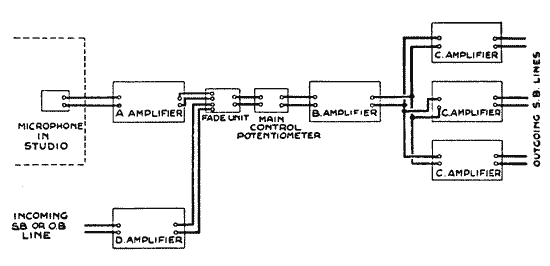
Figure 1:
Typical arrangement of control room amplifiers
Typical arrangement of control room amplifiers
The types of amplifiers will now be considered in more detail.
A Amplifier
This amplifier (see Fig.2, below) is a three-stage resistance-coupled amplifier having input and output transformers. Its input impedance is made 300 ohms to suit the output from carbon microphones which, until recently, were used more than any other type. Where a condenser microphone is used it has its associated single-stage amplifier located with it in the studio and the output impedance of this amplifier is made suitable to work into the 300 ohms input impedance of the A Amplifiers. The output level of the condenser microphone amplifier is also attenuated locally, where necessary, so that all microphones in use deliver transmission at approximately the same level to the A Amplifier input for a given sound intensity in the studio. Similarly where gramophones are used the gramophone attachment is followed by a network such that (a) the transmission level is approximately the same as that obtained from a carbon microphone, and (b) 300 ohms forms a satisfactory termination. Normally one particular A Amplifier is associated with each studio, but any one may be used for any studio if required, since the input is suitable for all types of microphones, gramophones, and associated mixers, in use.
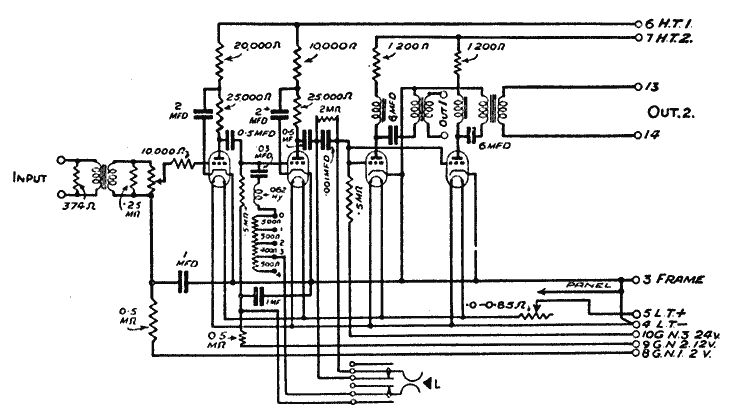
Figure 2: Diagram of an A amplifier
A switch is provided on the front of each A Amplifier which when operated inserts two correction circuits, one in the second grid circuit, and one in the third grid circuit. These circuits are such that when in use they modify the frequency characteristic of the amplifier to compensate for the frequency characteristic of certain microphones.
The third stage is duplicated, the first output being used to pass the transmission to the input of the fade unit and potentiometer used for controlling, while the second output is used to pass the transmission, via a loudspeaker amplifier, to the Echo Room, where it is picked up on another microphone and passed, via a separate A Amplifier, to another input of the same fade unit to provide echo. When echo is not required the second output is not connected through to the Echo Room. Indirectly heated valves are used to reduce valve noise (that is to say, "ponging") and to minimise interference incoming from the filament supply leads, caused by switching other amplifiers fed from the same battery. To reduce further such interference a decoupling choke and condenser are included in the filament supply to each amplifier. The grid and anode circuits of the first and second stages are also decoupled to minimise interference incoming via grid bias and high-tension supply leads.
The A Amplifier has an overall voltage magnification of approximately 360 (51 decibels). The transmission level at the output of all A Amplifiers should be approximately the same, to facilitate fading from one studio to another, and to secure this the overall voltage magnification of the A Amplifier is reduced in cases where the output level from the microphone is high, as in studios where an orchestra or band is playing. This reduction of magnification is obtained by means of the potentiometer in the first grid circuit. In practice the full magnification is only required in the case of talks studios where the sound intensity at the microphone is relatively low.
The filament supply is 4 volts, the high-tension supply 300 volts and the grid negative bias 2, 12, and 24 volts for the first, second, and third stages
A Puzzle
It's mentioned in this article
and elsewhere that there were 21 amplifiers for the studios - but there
were 22 studios. Which one didn't have an amplifier? Possibly 7A: there
are references stating that its output was available on the 6A mixer,
so perhaps it wasn't available as a separate source in control room,
and therefore didn't need an amplifier.
There are 31 A Amplifiers in all; 21 used for studios, 5 for Echo Rooms, 3 for miscellaneous purposes, and 2 spare.
B Amplifier
This is a three-stage resistance-coupled amplifier similar in many respects to the A Amplifier. The main function of this amplifier is to make good the loss introduced by the controlling potentiometer and to amplify the transmission, from whatever source it is obtained, to a specified level, referred to as zero level. This level corresponds to 10 milliwatts of A.C. power for a sine wave, so that as the normal output load is 600 ohms, this gives 2.45 volts R.M.S. across the output terminals. This means that during a programme the level at the B Amplifier output will be such that on loud musical passages the mean A.C. voltage across the output terminals will be 2.45 volts. The use of the B Amplifier to overcome the loss in the controlling potentiometer can be seen by reference to the Transmission Level Diagram (Fig. 3).
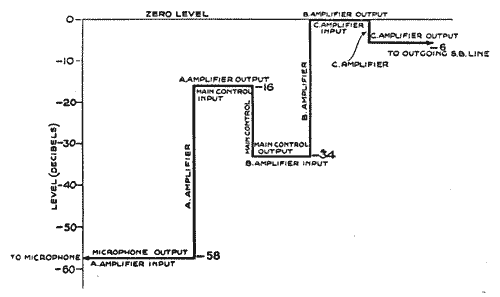
Figure 3:
Typical level of transmission
Typical level of transmission
The voltage magnification of the amplifier is approximately 200 (46 dbs.). In practice the full magnification is seldom required and it is reduced by means of the potentiometer in the first grid circuit to a value of about 80 (38 dbs.).
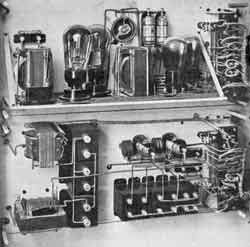
Back view of the B amplifier bay
The B Amplifier is fed with 6 volts, 300 volts, and grid bias tappings of 2, 12, and 24, from the Control Room central batteries.
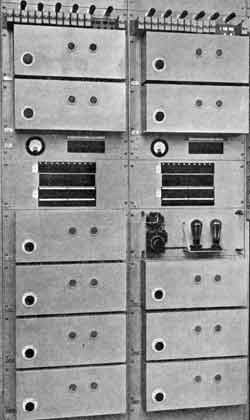
C amplifier bay with the cover removed
from one amplifier
The C Amplifier is a single-stage trap valve amplifier having no voltage amplification and serving to separate each individual outgoing line from the B Amplifier output. In many cases it is required that the level of the transmission outgoing on a trunk line shall be less than the specified zero level, and in such cases the level is reduced by means of the C Amplifier input potentiometer.
D Amplifier
This is similar to a B Amplifier except that an additional output stage is introduced for echo purposes. It is used to amplify the transmission incoming from any line and has a maximum voltage amplification of 200 (46 dbs.). As the level of such incoming transmissions may vary considerably for different lines the overall magnification of the amplifier can be varied by means of the potentiometer in the first grid circuit.
General
In addition to the above four main types of amplifiers there are various other amplifiers for special purposes. Among these are Trap Valve Amplifiers which have three separate output stages, one for supplying the "controlling" engineer's headphones, one for supplying headphones in studios and offices in the building, and one for supplying loudspeaker circuits in various parts of the building. Six of these amplifiers are allocated for transmission programmes, one being permanently connected to the output of each of the six transmission B Amplifiers. Thus any headphone or loudspeaker circuit may be supplied with any transmission programme at any time by connecting this circuit to the output of the particular Trap Valve Amplifier. In addition there are three spare Trap Valve Amplifiers which can be used for rehearsals or miscellaneous purposes.
The programme is fed into the loudspeaker circuits from the output of the Trap Valve Amplifier at ordinary headphone strength, and at each loudspeaker point a two-stage amplifier raises the level to full loudspeaker strength. This amplifier is operated from the A.C. mains and has a single valve in the first stage, and two valves in push-pull in its output stage.
From the 1934 Year Book
How Broadcasting House is Run
Enough has been written on Broadcasting House for it to be realised that the house itself is essentially functional, not only from a purely mechanical aspect, but from the point of view of the human element by which it is ensured that the mechanism carries out its allotted task.
It might be thought that, apart from the actual transmissions or performances in the studios, there is little about Broadcasting House to distinguish it from the thousands of other large offices in London or the Provinces. There are, however, very many differences, and while it is essentially the preparation and presentation of programmes which account for these, the organisation both of personnel and studios provides work which is in marked contrast to the normal business routine. For example, individual programmes and programmes as a whole are built on a co-ordinate design, or may be dependent upon some personality, and it can easily happen that some unexpected defection causes an unavoidable change of plan - an artist may fall sick or a musical work be not available; this will in many cases necessitate a complete revision of many days' arrangements in order to maintain the sequence and balance of the altered programme in relation to those preceding, following, or providing alternatives to it. It is also vitally essential that every cog in the intricate organisation should not only intermesh with its complementary cog, but that each and all of them should work almost to a time schedule of seconds. The organisation must therefore be sufficiently rigid to ensure punctuality in the transmissions, but at the same time be elastic enough to enable the temperamentally minded to give their best work without being irritated by too many regulations.
Let us consider the formation of a broadcast programme through its various stages from conception to performance, together with the ancillary services which those primarily concerned must needs either call upon, or with which liaison must be effected. The booking of artists is by no means necessarily the first step. An earlier stage is the casting of the programme, the requisitioning - either from the Corporation's own libraries or by hire - of the music or play as the case may be, and the settlement of any copyright questions which may be involved. Here naturally the Library, Booking, and Copyright Sections are brought in, while simultaneously the Programme Routine Section must be given the fullest possible details of the programme in order that Regions may be advised what material is available for them to take S.B., and so that their own programmes may be suitably formed to provide good alternatives to the National transmitters. (The Regions, on the other hand, notify Head Office what material of National interest they have available for the London programmes.) The programmes are at this stage many weeks ahead of actual performance, and it is the function of the Programme Routine Section also to feed the Radio Times with all its programme pages. This means not only the careful checking of all details such as titles, composers' names, speakers' degrees and qualifications, etc., but also the constant advising of all who may be affected of corrigenda and addenda to programmes. The advent of Empire Broadcasting has of course meant a duplication of these services for Empire programmes, and in this case the Empire Edition of World-Radio has similarly to be served with its programme pages at the appropriate period in relation to the date of publication of the various issues in time for the information to be available in the Zones themselves.
It will be appreciated that some differences between the programme actually performed and those published in the Radio Times or World-Radio are inevitable owing to the aforementioned unexpected changes, but it is vitally essential, not only for the publicity issued to the daily press to be up-to-date, but also for the actual programme which the Announcer uses at the microphone to contain every alteration or addition.
The system of simultaneous broadcasts moreover necessitates absolute accuracy at the time of performance, as the Engineering Branch, which is responsible for the provision of the interconnecting lines, must be provided with a chart showing in every detail whither and whence every programme is to go and the route which it has to take.
All these are purely routine functions, which are carried out in regard to all programmes of whatever type, and, broadly speaking, do not vary in their nature; they may, in fact, be looked upon as the framework of the actual programme organisation.
Now a little more detail as to the preparation and performance of the programmes themselves. The various departments having been informed which periods of the day's programme they are being asked to fill, the artists, actors or speakers having been booked and their material obtained, it is necessary to arrange for rehearsals. It is probably common knowledge that Broadcasting House has twenty-two studios, and it is equally probable that the question is asked, Why are so many needed for putting out two programmes? In the first place, it is a fallacy to think in terms of two simultaneously transmitted programmes only, since it is quite possible that in transmissions alone Broadcasting House might be doing its own National and Regional programmes at the same time as an Empire transmission, as well as contributing individual items to Regional programmes. There are, however, far more hours spent in rehearsals than in transmissions, and it is a matter of considerable adjustment and mutual give and take between those needing studio accommodation before all can be fitted in. Not only the question of the actual studios has to be considered at this juncture, but also the type of microphone which is necessary for the particular programme, whether or not echo is to be used for all or part of the transmission, and such details as what equipment is needed by the performers. Under this latter heading come such items as instruments for bands and orchestras, music stands, the conductor's rostrum or, in fact, any studio furniture of a temporary or removable nature. When, for instance, a military band is rehearsing in a studio on the eighth floor, all its instruments have to be taken from the band-instrument room in the basement, set out in the studio, and returned
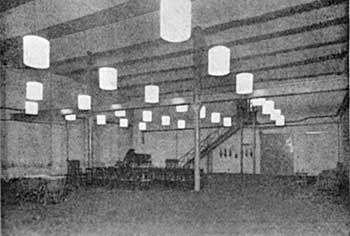
There were nine studios at Savoy Hill,
none of them big enough for larger musical programmes. "No.10" Studio
entered service in 1930 and was built in a disused warehouse on the
South Bank of the Thames, almost opposite Savoy Hill. At 67 x 70 feet
it was at the time the largest broadcasting studio in the country and
was used by groups as diverse as the BBC Symphony Orchestra and Henry
Hall's band. It closed in 1934 when the Maida Vale
studios entered service.
Related pages
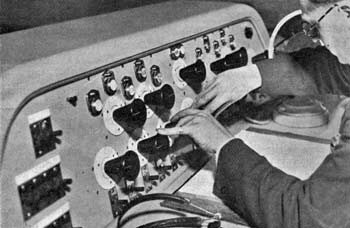
Alongside these preparations for actual programmes there are a certain number of auditions of new talent to be held, for although at the present time there is an excess of "straight" musical artists, the Dramatic and Variety Departments, the Children's Hour and the Talks Branch are always on the look-out for new material with which to vary their fare. Thus there are the three stages of audition, rehearsal, and transmission all proceeding (though of course in relation to different programmes) simultaneously and continuously. Nor is this all that attaches to the finished article - all programmes over a given period must come within a scheduled financial budget, and it is the business of the Programme Finance Section to watch this and to keep a fatherly eye both on expenditure and - in conjunction with the respective booking sections - on the terms of the contracts themselves.
There are many opportunities for the B.B.C. to come into contact with matters legal, not only defensively on the few occasions when, perhaps, a speaker may inadvertently give offence to some vested interest, but more often to guard the rights and privileges of the Corporation against broken contracts, infringements of copyright, and such-like happenings. For this purpose, as well as for other administrative necessities (leases, agreements, etc.), there exists a legal department which must be kept in close touch with all activities which involve contractual relations with outside bodies or persons.
Finally, the broadcast itself has to put a fitting crown on all the weeks of preparation which have gone before. From the Commissionaire on the door, the Receptionist in the hall, the Lift Attendant and finally up to the Announcer at the microphone, the artist must be conveyed easily and comfortably in order that the best result may be obtained.
As to programmes, then, the following chart gives them in skeleton form, in order to show briefly the sequence of programme construction and the departments closely affected.
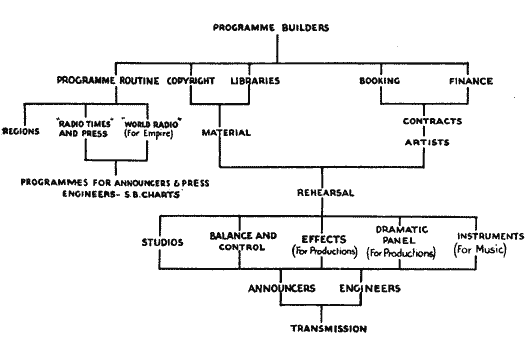
This naturally only visualises programmes in the form of a generalisation, and ignores such entertainments as Outside Broadcasts, Foreign Relays, News, or the hundred and one varieties of music and speech which are capable of being broadcast.
Foreign relays may take the form of an ordinary Outside Broadcast, a relay of some foreign programme, or a special broadcast from the studio of some overseas broadcasting organisation which is not broadcast by that organisation (some of Mr. Vernon Bartlett's talks from foreign capitals are instances of the last type).
The last kind of relay quite naturally gives rise from time to time to reciprocal facilities being asked for in this country for representatives of foreign stations. This is relatively simple where time differences between this country and the places of broadcast are not great, but with America, for example, it may mean special arrangements being made as to staff, etc., in the small hours of the morning. This, however, does not call for so much extra organisation since the regular Empire service started as when midnight or thereabouts really was the B.B.C.'s "Goodnight."
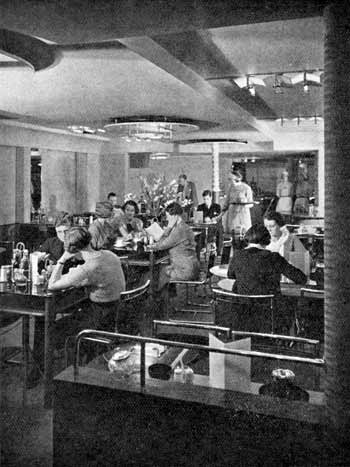
The Empire transmissions run into most of the early morning hours - and the staff on night shift must be fed at the normal mealtime intervals as though it were day. Furthermore, it is not possible for one announcer to cover the late evening and early morning programmes (finishing with the Canadian Zone at 3 a.m.), and also to take the Australasian Zone transmission, which begins at certain times of the year at 5.30 a.m.
Neither is it economically practicable to expect these members of the staff to live either on top of the building or permanently in a near-by hotel. As a result, arrangements must be made whereby one announcer may go to bed at 3 a.m. and be able to get a reasonable period of sleep (which means that his quarters must be sufficiently quiet to enable him to sleep whilst the day-time staff arrive and work), whilst the man who starts announcing at 5.30 a.m. must have facilities for sleeping up to the time he has to prepare for his programme. Similarly the Control Room staff concerned must be present all night as well as those House Engineers who are responsible for services such as the ventilation plant, heating, lighting, lifts, etc.
Some little time ago the listening public was "scandalised" by a speaker being unable to give his talk owing to a missing manuscript. 'There was naturally no excuse for such a lapse, but it may be of interest to realise that the routine must be such that the manuscript is submitted in reasonable time for it to be read, altered if necessary, and returned to the speaker, and for copies to be made for the Listener and World-Radio (in case it is desired to publish), for the Announcer (in case the speaker forgets to bring his copy), for file purposes (in case the speaker takes away the copy he has used) and in many cases for re-reading later in the evening for an Empire Zone. This is all fairly plain sailing provided the original MS. comes in punctually - which it frequently does not - although last-minute alterations are apt to be troublesome, but there are added complications when a topical talk is broadcast without a manuscript having been submitted or when a debate is extempore. The B.B.C. must be in a position to know definitely what has been said over the microphone, and where there is no manuscript a night stenographer (with reporter's speed of shorthand) must be present, who will not only provide a permanent record of the talk, but may have to get it typed in time for an Empire Zone the same night, or for sending to the printers the next morning if it happens to be press day for the journal concerned in the publication of it.
Some talks, or maybe composite programmes, are recorded either on wax or on magnetised steel tape for subsequent reproduction to the Empire Zones. This is an obvious convenience, since it enables the Empire listeners to benefit by items which could not be repeated several times for their especial benefit. The Blattner-Stille system, which uses steel tape, provides facilities for immediate replaying, while wax recording necessarily involves some delay between the actual performance and its reproduction. The Recorded Programmes Section of the B.B.C. handles the programme aspect of this work in liaison with the Engineers, who are responsible for the technical side. It is the Recorded Programmes Section which also provides - in response to requisition from the programme builders - the gramophone recitals which are such a popular feature of current programmes. This work may not be quite so simple as it appear on
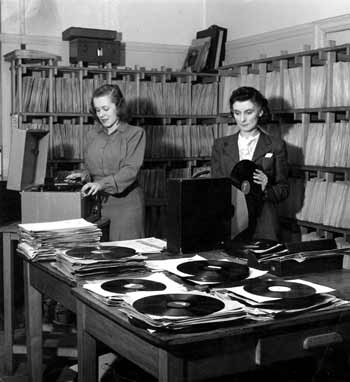
It is naturally most useful to the Corporation to know from listeners' letters how programmes are appreciated or disliked, and the Correspondence Sections provide tabulated details of criticism or appreciation, as the case may be, besides answering the innumerable inquiries on programme matters which are received daily. For this latter purpose, as well as for other needs, a detailed record of every item transmitted must be prepared - which in itself forms an invaluable history of the progress of broadcasting.
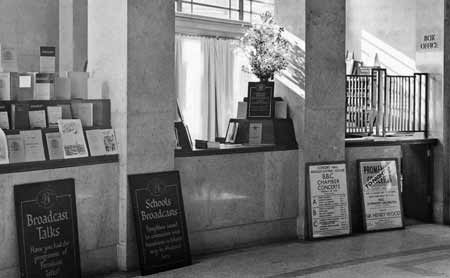
Television must be referred to in this survey of the activities within Broadcasting House, even if only because it calls for many requirements (other than technical) that ordinary broadcasting does not. To begin with, the studio itself is peculiar, in that the background for the artist is a white sheet, whilst the floor is designed in large black and white squares - like a chess board. Special lighting is also needed. Then, in view of the fact that television in its present state gives better results when the object is coloured black and white, artists' faces have to be made up with a dead white skin with the features marked out in black. Artificially blacked eyebrows are not perhaps unfashionable. Finally, the necessity for using two wavelengths - one for sound and one for vision - means that television must be given at times which do not interfere with the ordinary programmes; at present, then, these transmissions usually take place between 11 p.m. and midnight.
It is not possible to do more than mention many of these services which are so much part and parcel of the satisfactory conduct of a broadcasting organisation, but it may not be obvious to all listeners that such supplementary activities do exist, or that the home of British broadcasting does house so much that is not actual programme compilation or transmission.
One of these extraneous organisations has been created by the advent of Broadcasting House itself - namely, the handling of the thousands of applications from all and sundry for permission to see over the building. The B.B.C. is anxious to meet such requests from listeners as far as it is able, but it has been found quite impracticable to keep open house for all. In the first place, it is not possible for parties exceeding fifteen at a time to go round the building, since, for one reason, the guide's explanations would not be audible to a greater number; moreover, the congestion in passages, lifts and studios would become impossible. Furthermore it has been found from experience that considerable disturbance is caused to rehearsals by a procession of sightseers passing through studios, whilst, naturally, actual transmissions must exclude visitors from considerable parts of the building at all hours of the day. In consequence, only one tour a day (excluding Saturdays and Sundays, which are "closed" days) is all that can be handled, preference being given to those who have some definite contact with broadcasting, such as technical societies, persons in business relations with the B.B.C., visitors from Empire or foreign broadcasting staff and so forth. It is regretted, then, that disappointment is caused to many hundreds of applicants each week, but is quite unavoidable.
The administrative machinery required to co-ordinate all the different and differing sides of the B.B.C.'s work must of necessity be comprehensive and exact in its action, since as has already been pointed out, the aim of all departments must be to focus results on a nearly inflexible time schedule, while working under conditions of fluctuating circumstances where the human element is inevitably preponderant. Many details have been covered in this or earlier issues of the Year-Book, and the object here has been to try to enable those interested to picture some of the pieces which go to form the composite structure of broadcast entertainment.
From the 1933 Year Book
Ultra-Short Wave Broadcasting
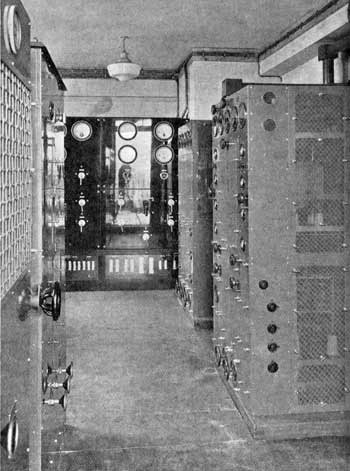
The Marconi type SWB4 transmitter
installed on the seventh floor of Broadcasting House.
In broadcasting it is necessary to provide a reliable service to as wide an area as possible, while at the same time using an economical amount of power at the transmitting end. For a reliable service the listener must receive the direct or ground ray, and must not have to depend upon the indirect or reflected ray, which is subject to fading and distortion of quality. The range of the direct ray on medium broadcasting wavelengths between 200 and 545 metres is about 50 to 80 miles, whatever the power. Beyond this distance, some fading is bound to occur. On shorter wavelengths the area which can be provided with a direct-ray service is less, but the strength of the indirect ray which can be heard at long distances from the transmitter, after the direct ray has completely died out, may be appreciable. This property of short waves is used for communication over long distances. For example, on 25 metres the direct ray may be inaudible beyond a range of about 20 miles, but it may be possible to receive the indirect ray after reflection from the Kennelly-Heaviside layer when it strikes the earth at a distance of perhaps 5,000 miles from the transmitter. The efficiency of a particular wavelength for long-distance communication depends upon several factors, such as the time of day and the time of year, and in no circumstances is a service of this character entirely free from fading and distortion.
Now a great deal of interference between broadcasting stations working on adjacent wavelength channels, or on the same wavelength, is caused by the indirect ray of a distant station being audible in the direct-ray service area of another.
Progress in the last ten years in wireless communication in general, and broadcasting in particular, has been so rapid that even the short waves (under 100 metres) are becoming congested. Ten years ago little was known about the performance of waves in this band, but intensive research has resulted in the rapid growth of long-distance communication services using these waves.
As already explained, short waves are of little value for providing a national broadcasting service because of the rapid attenuation of the direct ray and the objectionable features of the indirect ray. To meet the need for further expansion, attention is therefore being directed to ultra-short waves under 10 metres. The band of frequencies is an extremely wide one - for example, between 6 and 8.5 metres there are approximately 14,700 kilocycles, a band almost fifteen times as wide as the whole of the existing medium wave broadcasting band of 200 to 545 metres.
If therefore these waves can be used for broadcasting, the problem of congestion will almost cease to exist. Sufficient work has, however, already been done to show quite definitely that ultra-short waves can never replace the medium and long waves already used for broadcasting. The reason for this is that the range of the direct ray is even more limited than that discussed in connection with short waves. However, there are compensating advantages which make the subject worthy of further investigation.
In order to study this subject, the B.B.C., in co-operation with Marconi's Wireless Telegraph Co. Ltd., have installed at Broadcasting House an ultra-short wave transmitter, but before describing this in detail, some further advantages and disadvantages of this band of wavelengths, as far as are at present known, should be mentioned.
From earlier work carried out in America and Germany it is known that for all practical purposes the range is very limited. From what has already been said about short waves it might be thought that any hope of ultra-short waves being usefully employed for broadcasting would be doomed to disappointment. However, this is not so, since certain advantages appear which offset the disability of rapid attenuation of the direct ray.
The results of earlier experiments seem to show that these waves are not reflected at all by the Kennelly-Heaviside layer. Thus the indirect ray and all the troubles of interference which it brings with it virtually do not exist. It would be possible therefore to have a large number of ultra-short wave transmitters on adjacent wavelengths or even on the same wavelength, each providing a local service up to a range of say five miles in densely populated areas. Further, the scanty evidence so far obtained indicates an almost entire absence of atmospheric disturbances on these waves.
For a reliable service, the strength of the required transmission must be high compared with the strength of the interference from whatever source. Since the latter is apparently low, it follows that a relatively weak signal, as compared with that required on medium waves, will be sufficient for listeners' requirements. However, it is too early to say what order of field strength will be desirable, and consequently it is not known what transmitting power will be necessary to provide a reliable service over a range of say five miles from the transmitter.
To provide a true picture of what may be expected from this new field, a few of the disadvantages which are already known should be mentioned. Needless to say, further experiments may bring to light unexpected difficulties which may destroy what value these waves may have in other directions.
The strictly limited range has already been mentioned. The difficulty of reception must also be considered. Short-wave receivers are not so easy to handle by the non-technical listener as are ordinary broadcast receivers. However, as the need arises so will technical design improve, and it is not unlikely that the most common receiving set for ultra-short waves will consist of an ordinary medium-wave set in which provision has been made for adding a small short-wave unit to convert the set into a super-heterodyne or super-regenerative type of receiver.
It is believed that the ignition systems of motor cars cause considerable interference to receivers tuned to these wavelengths. Whether this can be overcome by a suitable increase in power of the transmitter has yet to be discovered. As no absolute measurements of field strengths on these waves have been made, it is too early to say whether the interference is due to its own high level or to the low level of signal from the transmitter.
Another likely trouble is shielding. It may be found that in a City with steel-frame buildings, reception is extremely unreliable. In one street it may be good and in the next no reception may be possible. This may lead to receivers being placed on the roofs of buildings, or, alternatively, the aerial (which, of course, is very short on these waves) may be on the roof and connected by means of a high-frequency transmission line to one or more receivers on the floors below.
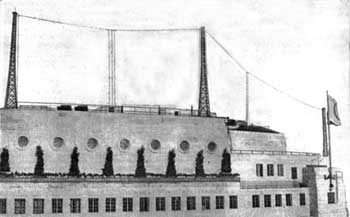
The transmitter consists of four units, the main rectifier unit, the auxiliary rectifier unit, the modulator unit, and the oscillator unit. Power is supplied
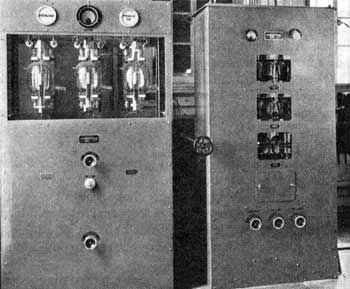
The Rectifier Units
The second unit contains the auxiliary rectifiers for providing the various D.C. voltages for the earlier stages of the transmitter. A motor-generator set is provided for heating the high-frequency amplifier and modulator valve filaments, but the drive valve is heated by a 6 volt accumulator.
The third unit contains three stages, a sub-sub-modulator, a sub-modulator, and the main modulator comprising four valves in parallel. A high-power choke
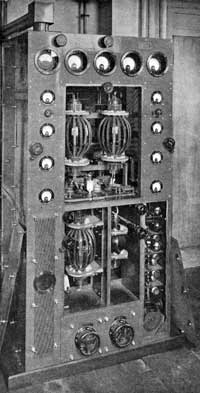
The Master Oscillator and Amplifier Unit
Finally, there is the fourth unit (right), which contains nine stages of high frequency. The frequency of the carrier wave is determined by a Franklin master oscillator working on 2,150.54 kilocycles (139·5 metres). This is followed by a five-stage amplifier. The first and third stages triple the frequency by selecting the third harmonic, the second, fourth, and fifth being amplifying stages. The output frequency is therefore nine times the initial frequency, which is thus increased from 2,150.54 kilocycles to 19,354·86 kilocycles (15·5 metres).
The output of this amplifier is applied to the first high-power amplifier. The output of this stage is connected to a doubling stage, which gives the final carrier frequency of 38,709.72 kilocycles (7·75 metres). The last link in the chain is the final high-frequency amplifier consisting of two valves in parallel and modulation takes place at this level.
Of course, these figures apply to one adjustment only. The experimental transmissions have been started on this wavelength, but investigations will be made over a band of about 6 to 8·5 metres. It is quite possible that while a wavelength at one end of the band may give poor results, another a metre away may be very satisfactory.
Related page
Television in 1932
by J. L. Baird, Managing Director of Baird Television, Ltd.
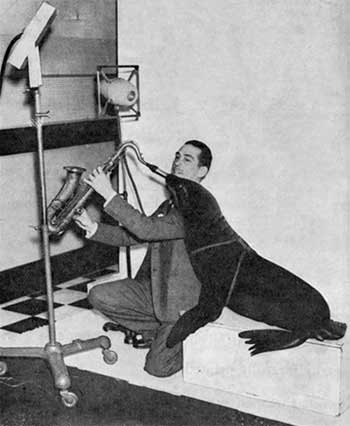
A seal being televised in Studio BB
After nearly three years of experimental transmissions emanating from the Baird Studios in Long Acre and broadcast by the London Regional transmitter of the B.B.C., a sufficient degree of advancement has been made to justify the B.B.C. taking over the studio side of the work. In my opinion this constitutes the most important step which has yet been taken towards the realising of proper commercialisation and the introduction of television to the public at large.
It may come as a surprise to many to learn that as far back as 1926 television transmissions were broadcast by the B.B.C. These, however, were of an entirely experimental nature and were received only on our own machines; for apparatus at that date was not in the hands of the public. From these crude beginnings we were able to establish that television could be broadcast successfully by the B.B.C. transmitters, and from that date a steady progress commenced.
Negotiations with the B.B.C., which took place over a rather lengthy period, culminated in September 1929, when the first official broadcast of television was made through the new London Regional Station at Brookmans Park. A spirit of friendly collaboration was established and considerable technical knowledge of this important side of television has been acquired.
Steady progress then commenced, one of the results of which was the broadcasting of the play "The Man with the Flower in his Mouth," which was due to the united efforts of Mr. Sydney A. Moseley, Mr. Val Gielgud, and Mr. Lance Sieveking.
Another landmark in television progress was reached in June 1931, when a view of the winning post at the Derby was broadcast. This was repeated in 1932.
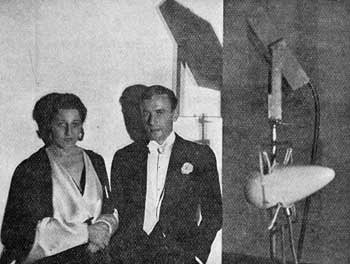
Miss Amy Johnson and Mr. J. A. Mollison
being televised on the latter's return to England after his Atlantic
flight.
In spite of the large amount of information which has been disseminated on the subject of television, I find that the majority of the general public are still in complete ignorance of what television means and how the process is effected.
In the space at my disposal, therefore, I propose briefly to outline both the transmitting and receiving sides of the problem.
First of all we mean by television the process of being able to see, through the medium of electrical methods of transmission, the reproduction of images of living, moving, or stationary objects which are at some distance from the observer. It can r really be looked upon as the reproduction of sight, for it is possible to witness visually what is happening at some distance just as if we were eye-witnesses on the spot.
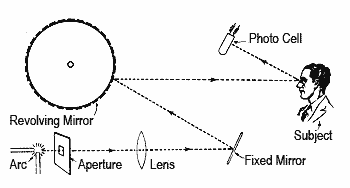
A bank of photo-electric cells is placed in front of the artist, and this "television eye" follows the movement of the spot of light and picks up that amount of light which is reflected from the spot playing on the subject being televised. A corresponding current variation is then produced in the cell circuit, and at the next instant, when the spot has moved to its adjoining position in the light strip, a different amount of light is reflected and the cells respond accordingly.
In this simple way the scene is analysed, and the television signals are made to modulate the carrier-wave sent out by the broadcasting station and are transmitted through space as ordinary wireless signals. These can be detected and received in the normal manner by anyone possessing a wireless receiver. If however, the individual tuned in vision radio signals and passed them on to a loudspeaker, he would be rewarded with a peculiar note which makes no pretence at being musical. On the other hand, if the signals from the output circuit of the wireless receiver are passed to a "Televisor receiver" then the result will be an intelligible image which, in effect, is a replica in miniature of the artist in the television broadcasting studio.
The vision-receiving apparatus, in order to bring this about, must consist of a source of illumination, the intensity of whose light can be made to fluctuate in exact conformation to the variations which originally take place in the photo-electric circuit at the transmitting end. In the original disc model machine this source of illumination was a flat plate neon lamp whose large electrode glowed brightly or darkly according to the signal strength which was made to modulate it.
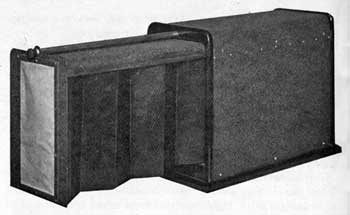
The new Baird "Televisor" (receiver),
which gives a black-and-white image on a screen
Television Abroad
In Germany, Fernseh A.G., a combination of the Baird Company, the Zeiss Ikon Optical Company, the Bosch Magneto Company and the Loewe Radio Company, which was formed in 1929 to develop our system of television, has supplied a transmitter to the German Post office which is very similar to that used by the B.B.C., and television in Germany is developing along parallel lines to developments in this country and we work in the closest collaboration.
A similar state of affairs exists in France, where Television Baird-Nathan is using the wireless station P.T.T. on the outskirts of Paris for the experimental broadcast of television, and we are now constructing a transmitter for them on the same lines as that being used in Broadcasting House.
In the United States of America extensive work is being done with television by the members of the huge combine known as the Radio Trust, and in addition numerous broadcasting stations are sending out television transmissions similar to those in Europe. The Baird Company of England has an affiliated Company in America, and last year W.M.C.A., one of the large broadcasting organisations of New York, arranged to take up the British system for broadcasting television, in preference to any American system offered them. An agreement was fixed with them, but the British Company was refused permission to broadcast in America by the Federal Radio Commission on the grounds that - to quote one of the leading technical journals:-
"…although the application was made in the name of W.M.C.A., an American Company, the proposed station would be operated jointly with Baird Television Corporation, Ltd., a British concern. According to the Commission, the granting of a licence would, in effect, give undue authority to the British Company in violation of the section of the Radio Law prohibiting alien ownership or directorates of Companies holding wavelength privileges in the United States."
It might be advantageous to our "Buy British" policy if this country were to adopt a similar attitude towards American-controlled concerns.
Television for the Cinema
The application of television to the cinema and places of public entertainment involves the use of a large screen, and considerable development work has been done in this direction.
The broadcasting of the play "'The Man with the Flower in his Mouth" was not only shown on the ordinary "Televisor" receivers but was also shown to a large audience on the roof of the Baird Long Acre premises on a screen 2 feet by 5 feet, and the same screen was shown in Paris, Berlin, and Stockholm; but while it attracted large audiences, the pictures could not in any way compare with the cinematograph, and the attraction was one of novelty.
Since that time the screen has been so far developed that it is now approaching the perfection necessary to give full entertainment value apart from the curiosity attraction, and I believe that one of the largest fields for television lies in the cinema of the future.

